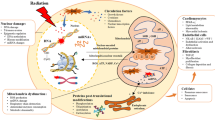Abstract
The purpose of this study was to investigate the role of Sestrin2 in response to radiation-induced injury to the heart and on the cardiomyopathy development in the mouse. Mice with genetic deletion of the Sestrin2 (Sestrin2 knockout mice [Sestrin2 KO]) and treatment with irradiation (22 or 15 Gy) were used as independent approaches to determine the role of Sestrin2. Echocardiography (before and after isoproterenol challenge) and left ventricular (LV) catheterization were performed to evaluate changes in LV dimensions and function. Masson’s trichrome was used to assess myocardial fibrosis. Immunohistochemistry and Western blot were used to detect the capillary density. After 22 or 15 Gy irradiation, the LV ejection fraction (EF) was impaired in wt mice at 1 week and 4 months after irradiation when compared with sham irradiation. Compared to wt mice, Sestrin2 KO mice had significant reduction in reduced LVEF at 1 week and 4 months after irradiation. A significant increase in LV end-diastolic pressure and myocardial fibrosis and a significant decrease in capillary density were observed in irradiation-wt mice, as well as in irradiation-Sestrin2 KO mice. Sestrin2 involved in the regulation of cardiomyopathy (such as myocardial fibrosis) after irradiation. Overexpression of Sestrin2 might be useful in limiting radiation-induced myocardial injury.





Similar content being viewed by others
References
Budanov AV (2011) Stress-responsive sestrins link p53 with redox regulation and mammalian target of rapamycin signaling. Antioxid Redox Signal 15:1679–1690
Cutter DJ, Schaapveld M, Darby SC, Hauptmann M, van Nimwegen FA, Krol AD, Janus CP, van Leeuwen FE, Aleman BM (2015) Risk of valvular heart disease after treatment for Hodgkin lymphoma. J Natl Cancer Inst 107:008
Eldabaje R, Le DL, Huang W, Yang LX (2015) Radiation-associated cardiac injury. Anticancer Res 35:2487–2492
Gao S, Wu R, Zeng Y (2012) Up-regulation of peroxisome proliferator-activated receptor gamma in radiation-induced heart injury in rats. Radiat Environ Biophys 51:53–59
Garaeva AA, Kovaleva IE, Chumakov PM, Evstafieva AG (2016) Mitochondrial dysfunction induces SESN2 gene expression through Activating Transcription Factor 4. Cell Cycle 15:64–71
Kopnin PB, Agapova LS, Kopnin BP, Chumakov PM (2007) Repression of sestrin family genes contributes to oncogenic Ras-induced ROS up-regulation and genetic instability. Cancer Res 67:4671–4678
Lee JH, Budanov AV, Karin M (2013) Sestrins orchestrate cellular metabolism to attenuate aging. Cell Metab 18:792–801
Mezzaroma E, Di X, Graves P, Toldo S, Van Tassell BW, Kannan H, Baumgarten C, Voelkel N, Gewirtz DA, Abbate A (2012) A mouse model of radiation-induced cardiomyopathy. Int J Cardiol 156:231–233
Saada HN, Said UZ, Meky NH, Abd El Azime AS (2009) Grape seed extract Vitis vinifera protects against radiation-induced oxidative damage and metabolic disorders in rats. Phytother Res 23:434–438
Seo K, Ki SH, Shin SM (2015) Sestrin2-AMPK activation protects mitochondrial function against glucose deprivation-induced cytotoxicity. Cell Signal 27:1533–1543
Shin BY, Jin SH, Cho IJ, Ki SH (2012) Nrf2-ARE pathway regulates induction of Sestrin-2 expression. Free Radic Biol Med 53:834–841
Slezak J, Kura B, Ravingerová T, Tribulova N, Okruhlicova L, Barancik M (2015) Mechanisms of cardiac radiation injury and potential preventive approaches. Can J Physiol Pharmacol 93:737–753
Taunk NK, Haffty BG, Kostis JB, Goyal S (2015) Radiation-induced heart disease: pathologic abnormalities and putative mechanisms. Front Oncol 5:39
Weintraub NL, Jones WK, Manka D (2010) Understanding radiation-induced vascular disease. J Am Coll Cardiol 55:1237–1239
Wu R, Zeng Y (2009) Does angiotensin II-aldosterone have a role in radiation-induced heart disease? Med 72:263–266
Wynn TA (2004) Fibrotic disease and the T(H)1/T(H)2 paradigm. Nat Rev Immunol 4:583–594
Yarnold J, Brotons MC (2010) Pathogenetic mechanisms in radiation fibrosis. Radiother Oncol 97:149–161
Acknowledgments
This work was supported by the National Natural Science Foundation of China (No. 81201803).
Author information
Authors and Affiliations
Corresponding author
Ethics declarations
Conflict of interest
The authors declare that they have no conflict of interest.
Rights and permissions
About this article
Cite this article
Zeng, YC., Chi, F., Xing, R. et al. Sestrin2 protects the myocardium against radiation-induced damage. Radiat Environ Biophys 55, 195–202 (2016). https://doi.org/10.1007/s00411-016-0643-8
Received:
Accepted:
Published:
Issue Date:
DOI: https://doi.org/10.1007/s00411-016-0643-8




